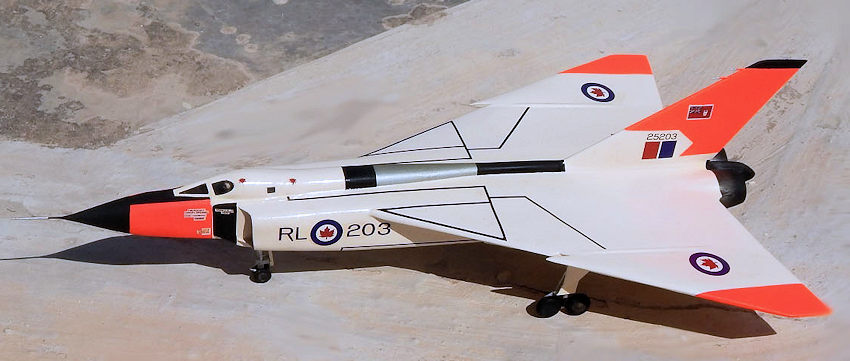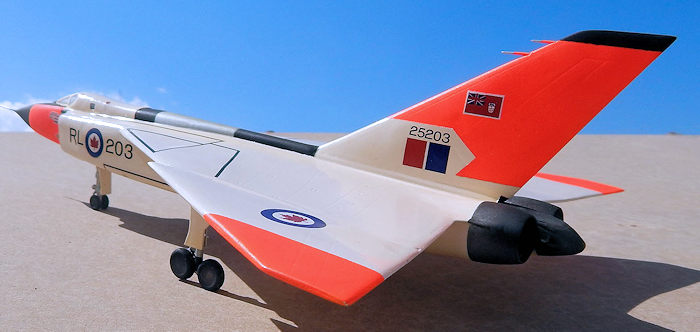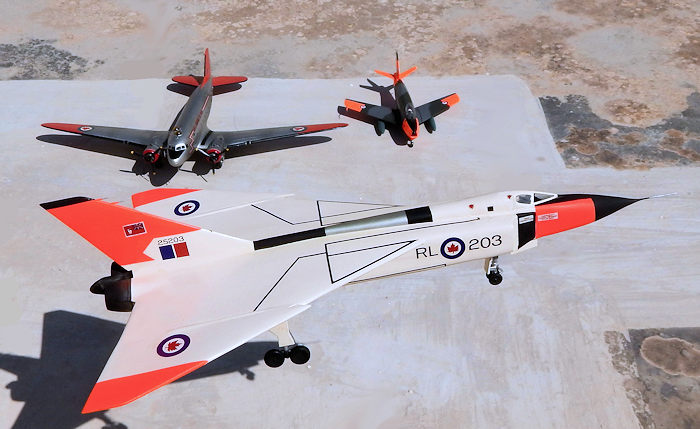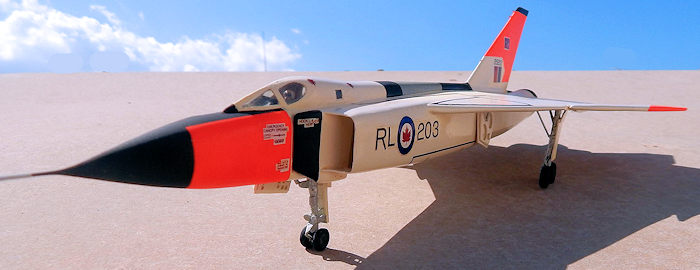
| KIT #: | |
| PRICE: | |
| DECALS: | None supplied |
| REVIEWER: | Carmel J. Attard |
| NOTES: | A vac-form kit in white styrene consisting of 37 vac parts, no undercarriage gear and no decals |

| HISTORY |
The Avro CF105 Arrow was, at the time of its cancellation on 20 February 1959, undoubtedly one of the most advanced interceptor fighters extant. Few would now argue that the decision by Mr. Diefenbaker, the then Canadian Prime Minister, to terminate the development programme of this aircraft and its power plant after the expenditure of some £108 million was not an error of magnitude; one underlined a mere three years later when it was found necessary to acquire from the USA the two seat McDonnell F-101B Voodoo to fulfil the role for which the Arrow had been originally intended.
 At the
time of the Arrow cancellation Mr. Diefenbaker stated that Canada would rely
mainly on Bomarc SAM missile, although during the tenure of his government, the
warhead of the missiles were sand-filled, and it was in later four years that
the nuclear warheads were delivered to make the Bomarc operational.
At the
time of the Arrow cancellation Mr. Diefenbaker stated that Canada would rely
mainly on Bomarc SAM missile, although during the tenure of his government, the
warhead of the missiles were sand-filled, and it was in later four years that
the nuclear warheads were delivered to make the Bomarc operational.
It was originally scheduled to provide the backbone of Canada’s air defences in the sixties, the CF105 Arrow passed through a number of major design and equipment changes from preliminary study in 1953 to the placing of an order for thirty-seven development and pre-production machines four years later.
The first four machines RL-201 to RL-205 were each powered by two Pratt and Whitney J75 turbojets of 16,500 lbst and 23,500 lbst with full afterburning and were designated Arrow Mk1s but the sixth and subsequent aircraft were to have been Mk2s with Orenda PS-13 Iroquois turbojets rated at 22,000 lbst and 28,000 lbst with full afterburning.
An outstanding feature of the Arrow was the removal weapons pod which was 18 feet long, 8 feet wide and 3 feet high, larger than a B-29 bomb bay. This allowed eight Falcon or four Sparrow air to air missiles to be carried internally. Another feature was the Automatic Flight Control System which permitted automatic flight from take-off to landing ...in 1958.
 The first
CF-105 flew in March 25,1958 and the remaining few Mk1s had all flown by the
time development terminated on Feb 20th
1959, when the sixth machine, the first Iroquois-powered Mk2, was on the point
of flying and the seventh, eighth, ninth and tenth machine were virtually
complete.
The first
CF-105 flew in March 25,1958 and the remaining few Mk1s had all flown by the
time development terminated on Feb 20th
1959, when the sixth machine, the first Iroquois-powered Mk2, was on the point
of flying and the seventh, eighth, ninth and tenth machine were virtually
complete.
During flight trials the Arrow Mk1 attained Mach 2.3 and 1,000 mph had been exceeded at 50,000 ft while the aircraft was still climbing. Initially a highly sophisticated electronic system the RCA Astra, had been designed for the Arrow, and the armament was to have comprised up to eight Sparrow missiles; but prior to the Arrow’s termination, the Astra system had been cancelled and the decision to adopt an ‘off-the-shelf’ Hughes fire-control system and Falcon missiles.
| THE KIT |
The kit comes in a sealed bag containing white styrene sheets with the vac parts. Instructions are printed on two yellow pages. These show the kit parts, an exploded assembly view, a detailed undercarriage that has to built from scratch; section drawings that depict vertical and horizontal bulkheads; 1/72 three view scale plans; scrap views of fin/rudder detail; views of forward fuselage, pilot ofice, and cockpit interior as well as control panels detail. History and color notes are also given along with construction suggestions. Instructions are adequate especially of the more complicated assembly areas.
| CONSTRUCTION |
This is a big model for a two seat fighter which
in real life has a span of 50ft, a length of 83 feet and a height of 21 feet.
Five arrows were built and flown before the whole project was cancelled.
Assembly starts with cutting the different kit parts and mark them as indicated on the assembly instructions. Each of these parts is
sanded to the required size and shape. The nose section and the tail pipes are
assembled first to form complete pieces. This is followed by preparing the lower
fuselage and upper center section. These should dry fit the nose section and
tail pipes particularly ntil the correct depth of fuselage is obtained.
and mark them as indicated on the assembly instructions. Each of these parts is
sanded to the required size and shape. The nose section and the tail pipes are
assembled first to form complete pieces. This is followed by preparing the lower
fuselage and upper center section. These should dry fit the nose section and
tail pipes particularly ntil the correct depth of fuselage is obtained.
The main landing gear wells and doors are then cut clean from the lower wing surface and turned over so that the curve would be tpwards the top of the well. The wells were detailed as one desired provided one seeks details from other sources. The wing section was retained at the junction of the lower wing root and fuselage by inserting a rib of scrap plastic into the root.
Landing gear legs were built from long strips of sprue of correct diameter with narrow tape wrapped for varying section. wheels of the correct size came from the spares box. Construction of the intakes and and the assembly of the front and rear fuselage sections required a certain amount of filler followed by careful rubbing down as the plastic gets quite thin on some of the deeper drawn parts. Wings were carefully cut and sanded until mated the upper and lower parts together. Then inserted a locating sprue piece at the roots to go inside the fuselage side to secure the two wings in place when attached to the fuselage.
| COLORS & MARKINGS |
 The
completed kit was airbrushed overall white and masked in order to apply the
orange/red day glow areas and the anti glare panel. With masking removed the
original white areas were refreshed with another coat of white, Well interiors
was also painted white and most of the gear was in silver.
The
completed kit was airbrushed overall white and masked in order to apply the
orange/red day glow areas and the anti glare panel. With masking removed the
original white areas were refreshed with another coat of white, Well interiors
was also painted white and most of the gear was in silver.
No decals come with the kit which is a pity as the kit was quite pricey. These had to be dug out from the spares decal box. In spite of all the problems encountered with this rare vac kit the assembly went quite smooth and moved forward one step at a time. I am now quite pleased with the resulting model which sits proudly next to a Dakota and a Canadair Sabre from same era.
| CONCLUSIONS |
The kit is recommended to those experienced modelers who enjoy building Canadian type of military aircraft.
29 August 2016
Copyright ModelingMadness.com If you would like your product reviewed fairly and
fairly quickly, please
contact
the editor or see other details in the
Note to
Contributors.